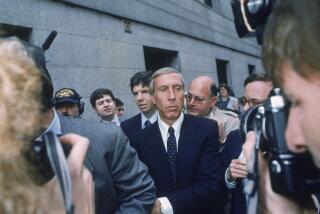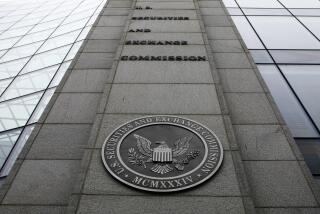Insider-Trading Probes Make a Comeback : Wall Street: SEC official notes more investigations than at any time since the takeover boom of the 1980s.
NEW YORK — A wave of mergers and acquisitions in the United States is reviving an unwanted headache for regulators: insider trading.
“We have more insider-trading investigations now than at any time since the takeover boom in the 1980s,” said Thomas Newkirk, associate director of enforcement for the Securities and Exchange Commission.
Several of this year’s largest merger announcements have been preceded by unusual trading. Thursday, shares of Scott Paper Co. jumped $2.50 to $46.875. Friday morning, the Wall Street Journal reported that Kimberly-Clark Corp. was negotiating to buy the company.
During the merger bonanza of the 1980s, insider trading was equated with greed on Wall Street as prosecutors won convictions against Ivan Boesky, Michael Milken and others. The alleged culprits of the 1990s tend to be more ordinary working folk.
In February, the SEC charged 17 people with civil violations of insider-trading laws related to trading in shares of AT&T; Corp. acquisition targets, including NCR Corp. and McCaw Cellular Communications Inc. Two were former AT&T; employees. Charles Brumfield, former vice president in the human resources department, pleaded guilty in connection with the case.
Earlier this month, the SEC sued a Salomon Bros. Inc. analyst, Frederick Moran, and his father, a money manager in Greenwich, Conn., for alleged insider trading in the failed merger of Tele-Communications Inc., the nation’s largest cable systems operator, and Bell Atlantic Corp.
“We brought 45 cases in the last fiscal year and the caseload is running about the same this year,” the SEC’s Newkirk said.
Opportunities are increasing for people to use advance knowledge of a merger to make illegal profits. About $178 billion in mergers have been announced since the beginning of the year, putting 1995 on course to exceed last year’s $368 billion, according to Securities Data Co.
Regulators say they are looking at such transactions for any sign of trading picking up before the agreements were announced. That was the case for shares of Telular Corp., which said June 22 that it might seek a buyer for the company, and for Lotus Development Corp., which agreed to be bought by International Business Machines Corp.
On June 20, just before a New York state agency proposed a buyout of Long Island Lighting Co. for $17.50 a share, the utility’s stock jumped $1.50 to a seven-month high of $17.
One person who isn’t surprised by the recent rise in insider-trading cases is Gary Lynch, who as chief of enforcement at the SEC during the 1980s was one of the main people responsible for bringing about the convictions of Boesky and Milken.
“What’s happening now is exactly what everyone predicted back in the ‘80s: that with the number of high-profile cases brought, the incidence of insider trading would decline for a while, but as memories dulled, insider trading would pick up again,” said Lynch. “The temptation is too great for people to resist.”
More to Read
Inside the business of entertainment
The Wide Shot brings you news, analysis and insights on everything from streaming wars to production — and what it all means for the future.
You may occasionally receive promotional content from the Los Angeles Times.










